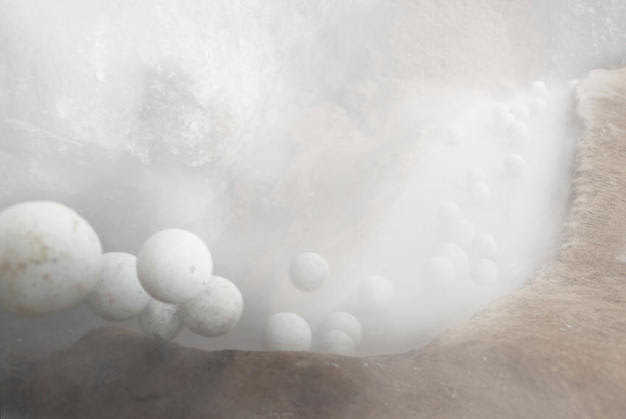Opening 12 March: 'Displacement' exhibition with (Here As The Centre Of The World, a DAI 2006-2009 project) participant Hrair Sarkissian and others at Akinci Gallery
Image: Miguel Angel Rios, Piedras Blancas, 2014, one-channel wall projection, 5:00 min
12.3 - 23.4.2016
Opening Saturday 12 March, 17:00-21:00hrs
The word displacement defines a change in position, involving movement, speed, and time. There are many layers and connotations related to this definition. In first instance, being in a state of displacement seems to refer to the simple act of being put out of place. Looking deeper, however, displacement may also comprise topics as forced migration, emotions of loss and longing for a place one has left behind. In this exhibition, displacement is meant to function as a word that meanders in between what is lost and cannot be brought back. It refers to the kinetic energy which lingers behind velocity or change; how things just go into directions which become unpredictable as we never know where things finally end up. The artists contributing toDisplacement - Hrair Sarkissian, Andrei Roiter, Basim Magdy, Miguel Angel Rios and Meriç Algün Ringborg - propose a narrative of subtle emotions and thoughts spinning around this elusive theme.
In his work 'Unexposed', London based Syrian artist Hrair Sarkissian (Damascus, 1973) explores the different phases of migration, persecution and displacement. This series of six photographs depicts the descendents of Armenian converts, who turned to Islam to escape the genocide that took place in the Ottoman Empire in 1915. Having rediscovered their roots but reconverted into Christianity, these descendants are forced to conceal their Armenian background. They remain invisible, unaccepted by Turkish society and partly excluded from the Armenian community. ‘Unexposed’ was presented in the Armenian Pavilion at the Venice Biennale last year, awarded with the prestigious Golden Lion Award.
Throughout the oeuvre of Andrei Roiter (Moscow, 1960), living and working in both Amsterdam and New York, the idea of being on the move has become a crucial subject. He is constantly mapping the world, as an observer, constantly creating a new order for his memories and excavating them as an archaeologist. What is extraordinary about Roiter’s paintings is the fact that he often depicts inhabitable dwellings as mysterious, solid objects—at times suspended in the air like in his painting 'A Place to Hide Above the Ground'—whereas his archetypical object, an old suitcase he took from Moscow when he moved to Europe in 1992, is hollowed out to become a spacious place.
In the poetic film 'Many Colors Of The Sky Radiate Forgetfulness' Basim Magdy (Assiut, Egypt, 1977), living and working in Basel, conjures up a kind of dreamstate of imagery, cobbled together with seemingly unrelated footage. Magdy shoots his film with a 16mm camera, cultivating the character of found footage by applying manual distortions: from unhinging the focus for a kaleidoscopic effect, to allowing double exposure or deliberate light leaks to saturate the film with flares of colour, thus endowing each frame with an anachronistic antiquity. Often, his films are ‘pickled’ in household solutions of Coca-Cola, vinegar or yeast, enhancing their ambiguity. In Displacement, Magdy presents his film with photographs of his ongoing series ‘Every Subtle Gesture’. Together, the works narrate a history of modernism seen from a few steps ahead, as a future in which the past occupies a ghostly presence. Magdy was recently awarded Artist of the Year 2016 by the Deutsche Bank.
The works ‘Infinity’ and ‘Eternity’ by Stockholm based artist Meriç Algün Ringborg (Istanbul, 1983), display a set of hands performing meditative and repetitious tasks; one ties and unties a decorative knot, the other endlessly enacts a trick with a pen. The decorative knot serves no use as a knot, the pen trick implies an endless interim of writing—the movement, not the outcome, serves as a place for contemplation. Over and over, Ringborg returns to the impulse that finds us forever trying to express ourselves to others, fitting words to ideas and emotions and the passage of time. Her work concentrates on issues of identity, borders, bureaucracy, language and translation through appropriated and ‘ready-made’ texts, collections, and archives; often composed with wry humour and playful delicacy.
Mexico based Miguel Angel Rios’ (Catamarca, Argentina, 1943) film ‘Piedras Blancas’ (‘White Stones’) explores the perpetual momentum of a greater whole set in motion. Solid and heavy white stones rapidly roll down the slope of a mountain as they search for the paths of least resistance, their tracks determined by existing trails in the landscape, channels eroded by animals or streams of water created by rain. The surreal image is breathtaking in its beauty, but in fact proposes a powerful metaphor: is this an innocent game, or a catastrophe in the making? Do these white stones represent people caught in a migrating frenzy? Combining controlled acts with coincidence, Rios reveals the unstableness of human condition, expressing his primary concerns with social power struggles, violence and geopolitics on an intriguing, symbolic level. The questions he raises with symbolic imagery may never be answered, yet there is always a haunting sense of urgency in his poetic juxtaposition of motion and matter.
AKINCI
Lijnbaansgracht 317
1017 WZ Amsterdam

